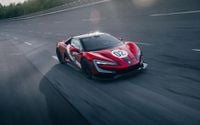For decades, the world of hypercars has been dominated by European legends—names like Bugatti, Koenigsegg, and Ferrari have long defined the upper limits of speed, power, and prestige. But on September 14, 2025, a seismic shift occurred on the smooth asphalt of Germany’s ATP Papenburg test track. BYD’s Yangwang U9 Xtreme, an all-electric hypercar from China, thundered past the competition and into the history books, clocking a certified top speed of 496.22 km/h (308.4 mph). In doing so, it became the fastest production car ever built, surpassing the previous record held by Bugatti’s Chiron Super Sport and rewriting the rules of automotive supremacy.
This jaw-dropping achievement didn’t just nudge the speed record a little higher; it shattered old assumptions about what electric vehicles (EVs) can do. According to ATP Papenburg’s official timing, the U9 Xtreme’s run wasn’t just a technical demonstration. It was a statement—a challenge to the established order and a promise that the future of speed might not come with a roar, but with a whir of electric motors.
The Yangwang U9 Xtreme’s feat is all the more remarkable given the context. Bugatti’s Chiron Super Sport, long the king of the hypercar hill, set its 490.484 km/h (304.8 mph) record back in August 2019 on a private 12-mile straight, giving it plenty of room to reach its maximum velocity. In contrast, BYD’s U9 Xtreme had to make do with the ATP banked oval, which features only a 2.5-mile straight. That meant German racing driver Marc Basseng, a veteran of the FIA GT1 World Championship, had to push the car to its limits—accelerating out of the banked corners at a staggering 180 mph, then rocketing up to over 308 mph before braking hard for the next curve. According to Will Lockett’s Newsletter, “at 300 mph, it was still accelerating fairly linearly at the same pace an economy car does from 0 to 60 mph.” In other words, the U9 Xtreme wasn’t even finished showing what it could do before the track ran out.
So, what makes this Chinese EV so special? For starters, the U9 Xtreme features a revolutionary 1200V electric architecture, a significant leap from the standard 800V system found in its sibling, the regular U9. This ultra-high-voltage platform allows for unprecedented power delivery and efficiency, overcoming the battery limitations that have long hampered EVs at the highest performance levels. Each of the car’s four wheels is powered by its own electric motor, each spinning at 30,000 rpm and producing 555 kW (744 horsepower). That’s a jaw-dropping total of 2,977 horsepower—nearly 50% more than the next most powerful production car, as highlighted by Will Lockett’s Newsletter.
But the magic doesn’t stop at the motors. The U9 Xtreme uses BYD’s Blade Battery technology, renowned for its safety and performance, with a 30C discharge rate that can sustain the brutal power demands required for such extreme velocity. The car’s semi-slick Giti tires and a revised DiSus-X suspension system provide the necessary grip and stability, while aerodynamic tweaks—including a longitudinal “shark fin”—help keep the car planted at speeds where even minor turbulence could spell disaster. The record-breaking run was completed on these bespoke tires, which are “an entirely different breed of tire from the Michelin tires used in the Bugatti’s run and in most other high-speed record attempts,” according to The Sun.
It’s not just the technical prowess that has the automotive world buzzing. The U9 Xtreme’s record is a cultural and symbolic moment. For generations, the pinnacle of automotive achievement was a European affair. Italian design, German engineering, French flair—these were the hallmarks of hypercar royalty. Now, a Chinese company best known for mass-market EVs has produced a $3 million unicorn that not only matches but exceeds the icons of the West. As GadgetReview quipped, “It’s like watching Netflix humble Hollywood studios, but for the $3 million hypercar set.”
Exclusivity is also part of the story. BYD will produce only 30 units of the U9 Xtreme, ensuring its place among the rarest and most coveted collectibles in automotive history. Whether each of these 30 cars will be mechanically identical to the record-breaker remains to be seen, but the achievement is enough to guarantee their desirability among collectors and enthusiasts alike, as noted by The Sun.
The U9 Xtreme’s accomplishments don’t stop at straight-line speed. The same car also set a Nürburgring lap time of 6 minutes and 59.157 seconds—an impressive feat, though not enough to top the leaderboard still dominated by the Xiaomi SU7 Ultra Prototype’s 6:22.091. While the U9X’s lap time has yet to appear on the official list of certified times, ATP has already validated its speed record, lending further credibility to BYD’s engineering prowess.
Of course, the world of hypercars is nothing if not competitive. Other contenders are already lining up for their shot at the title. The Swedish electric hypercar manufacturer Koenigsegg claims its Jesko Absolut has a theoretical top speed of 330.5 mph, pending tire approval and a suitable venue. Meanwhile, Hennessey’s Venom F5 is “engineered to exceed 300 mph,” according to the manufacturer’s website. As history shows, records are made to be broken—but for now, the U9 Xtreme sits at the top of the mountain.
This breakthrough comes at a time when the broader EV market faces its own set of challenges. According to Reuters, EV sales growth has slowed due to high initial costs, expensive insurance premiums (often attributed to fire risks and costly battery replacements), and lingering concerns about charging infrastructure and range—especially in extreme weather. Despite these hurdles, the U9 Xtreme’s success demonstrates that electric vehicles are not just viable alternatives, but can actually surpass the internal combustion engine’s most hallowed achievements.
For those who have followed the saga of the Tesla Roadster’s much-delayed return, the U9 Xtreme’s triumph is a wake-up call. As Will Lockett’s Newsletter put it, “Tesla Roadster Who? This is getting silly. But it will change everything.” With Chinese innovation now leading the charge, the future of high-performance automobiles looks more electric—and more global—than ever before.
The Yangwang U9 Xtreme’s record-breaking run is more than just a number on a speedometer. It’s a bold declaration that the future of speed, power, and prestige is up for grabs—and that the next chapter may well be written in Mandarin.




